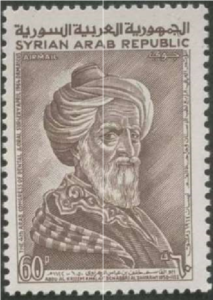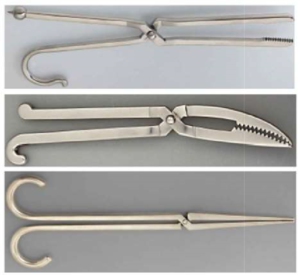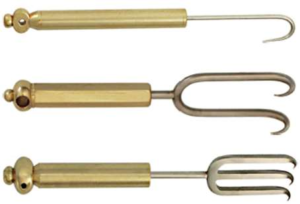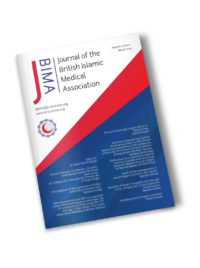
Abstract
Biomedical engineers are considered the personnel who provide tools that could be used in diagnosis and treatment of an illness or a disease. Biomedical engineers apply a variety of concepts (such as mechanical, chemical, optical, and electrical concepts) to solve medical and biological problems. Studying the history of biomedical engineering is beneficial as it frees the mind of the biomedical engineers from the narrow static image of the new modern concerns. Al-Zahrawi is considered one of the ancient pioneers in the biomedical engineering field.
Introduction
Al-Zahrawi (936–1013 A.D.) was named after AlZahraa, a city near Córdoba, Andalucía, Spain; it was where he was born and died. He is a Muslim surgeon (Figure 1) who had a wide reputation in Europe during the Middle Ages. He was a true inventor, creating many surgical instruments that were not known in the GrecoRoman era. The illustrations of such instruments in his encyclopedic work, Al-Tasrif, reflect his willingness to teach (1).
The weight of a positive doctor-patient relationship on the psychological state of the patient was promoted by him. He showed the importance of bedside clinical medicine (2). His ethical concept in research was shown by mentioning above sixty references in his work (3).
Fig. 1. A Syrian stamp issued on the fourth Arab congress of dental and oral surgery in 1964 and bears a drawing for Al or Al-Zahrawi.
Achievements in dentistry
Al-Zahrawi used several types of tongs for taking off teeth and the removal of tooth fragments, as shown in Figure 2. He used tweezers to extract the roots of teeth and jawbone fragments, as shown in Figure3 (4).
Fig. 2. Three different types of tongs for extraction of different types of tongs for extraction of
teeth and removal of tooth fragments (4).
Fig. 3. Tweezers for extraction of teeth roots and jawbone fragments (4).
He suggested the replacement of teeth displaced from their sockets because of trauma. He proposed the use of prosthetic dentures made of animal bones for replacing the missing teeth (5, 6, 7).
He also used minerals in oral and dental diseases. Alkali was used in the treatment of pyorrhoea. Alkyonion stone would be helpful for teeth whitening, gum strengthening, and pyorrhoea and putrefaction treatment. Alum was employed as a haemostatic, toothpaste, mouthwash, and for the treatment of gingivitis, pyorrhoea, and thrush. Moreover, Alum was used for consolidating loose teeth, preventing halitosis and putrefaction, strengthening gums, and healing mouth chancre. In fact, Alum is still often included in preparations for mouthwash and gargle for treating pharyngitis and cough.
Armenian bole was used for strengthening gums, buboes (swollen lymph nodes), and ulcers. Depending on polishing teeth, cleansing the mouth, and preventing halitosis, tooth decay, pyorrhea, and mouth cankers. Arsenic was used for mouth chankers and as a caustic. Lapis lazuli was applied in case of mouth cankers, its caustic activity, lime was used for loose teeth, gum decay, and chancre. Marcasite was mainly used as a dental painkiller. Strengthening the gums was the main function of orpiment (8, 9).
Achievements in Ear, Nose & Throat
Al-Zahrawi used a curved scalpel in the procedures of removing the swollen tonsils. The scalpel’s concave side is sharp, and the convex side is blunt, as shown in Figure 4. The curved scalpel could be used to cut off a pale and elongated uvula or to excise throat tumors (10, 11, 12).
Fig. 4. Curved scalpel for removing swollen tonsils (4).
He used a pointed cautery to treat otalgia, as shown in Figure 5. Several points on the auricle were cauterized (13). He used a fine scalpel (Arabic: Mibdaa Raqiq) to crash a foreign body that had entered the ear and swollen up inside the ear due to moisture, as shown in Figure 6 (4).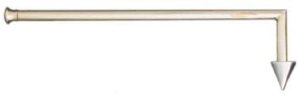
Fig. 5. Pointed cautery for treatment of otalgia (4).
Fig. 6. Fine scalpel for splitting foreign bodies that have fallen into the ear (4).
Achievements in Ophthalmology
He used scalpels to remove adhesions in the inner corner of the eye and to cut off pterygium, as shown in Figure 7 (4,14). He described a crescent-shaped cautery used in case of the eyelashes grew turned into the eye, as shown in Figure 8. The roots of the hair on the eyelid were cauterized to stop cornea irritation (4, 15). The same cautery was applied for the relaxation of the upper eyelid. The required length of cauterization was the length of the eyelid. The required thickness of cauterization was onethird the thickness of the skin. He noted that the physician should use tremendous delicacy to prevent burning the temples (14, 15, 16). 
Fig. 7. Scalpel for cutting off pterygium and removing adhesions in the inner corner of the eye (4).
Fig. 8. Crescent-shaped cautery for cauterizing the roots of the hair on the eyelid when eyelashes grow into the eye (4).
Aneurysm Treatment
In case of migraine headaches, he used a tip of a hook to twist and cut the superficial temporal artery. The hook could have one, two, or three prongs, as shown in Figure 9 (17, 18, 19, 20).
Fig. 9. Single, double, and triple hooks for lifting vessels (4).
When the enlargement of an artery at the mouth occurred, he suggested the usage of a knife to make a longitudinal incision at the affected area. He used hooks to widen the field of view to simply canvass the artery.
Then, he used an aneurysm needle and a double thread to tie the artery in two places. A scalpel was used to open an aperture between the two ligatures to let the infected blood out, as shown in Figure 10 (4, 21).
Fig.10. Scalpel for making an opening in infected artery
Bleeding Control & Wound Healing
In case of entropion, he used cotton wool dipped in egg white or mucilage of psyllium seeds under the eyelid before cauterization (13). In case of harelip, he was the first to use a wax plaster after cauterization for safe healing of wounds and the reconnection of the two sides of the cleft (22). Wax insulates the wound from the surrounding air which could cause the putrefaction of the wound (23).
In cases of the opening up of swellings occurring in the womb, a wool dressing soaked in an infusion of mallows (Malvaceae family) was placed on the pubes. A perfusion of honey, water, and decoction of liquorice (roots of glycyrrhizae) oraristolochia was used to wash the wound and the uterus. Then, ointments were applied (24). Green oil, also known as Egyptian oil or vitriol, was used as a hemorrhage stopper and swelling cleaner after its extirpation. Mallows were used to cool down the womb, relieve its swelling and heal the wound.
In cases of nasal polyps, he inserted a lead tube into the nostrils as a postoperative treatment. The lead tube was loaded with Egyptian oil or drying medicaments by instillation for the complete healing of the wounds. During the surgery, he recommended the use of vitriol in case of bleeding. As a sterilization procedure, the patient was asked to rinse his mouse out with salt and vinegar (7,22).
Achievements in Cosmetology
He classified his manufactured perfumes according to their beautifying properties. Hence, hand creams, nasal sprays, and mouthwashes were included. He was careful to address the cost of his recipes, giving both expensive and cheap alternatives for many of them (25, 26, 27). He modified Paul of Aegina’s technique for surgical management of moderate and severe gynecomastia in men to remove the excess breast tissues and maintain firm breasts (28, 29).
Achievements in Fractures & Dislocations
He favored stabilization in case of spinal injury. In case of the presence of bone fragments in the spinal canal, they should be cut down and removed using spars and winches. Then, the edges of the opening should be sutured (30, 31, 32). He preferred a delay of one or more days in applying bandages over splints to guard against swellings (33).
Acknowledgements
Recognition must be given to the Frankfurt and Istanbul Museums for the History of Science and Technology in Islam. The Istanbul Museum has copies of the instruments that are in the Frankfurt Museum, and both museums are founded by the same person, Professor Dr. Fuat Sezgin. Institute for the History of Arab-Islamic Sciences, which runs the Frankfurt Museum, kindly and generously authorized the reproduction of the instruments’ photos in this article.
References
- Saad MN. Could Al-Zahrawi Be Considered a Biomedical Engineer? IEEE Pulse 2016; 7: 5667.
- Elgohary MA. Al Zahrawi: the father of modern surgery. Annals of Pediatric Surgery2006; 2 (2): 82-87.
- Calvo E. Abu Al-Qasim Al-Zahrawi. Aspetar Sports Medicine Journal2012; 1 (1): 70-73.
- Sezgin F, Neubauer E. Volume IV: Catalogue of the collection of instruments of the institute for the history of Arabic and Islamic sciences. In: Sezgin F. Science and technology in Islam. Frankfurt am Main, Germany: Institute for the History of Arabic-Islamic Science, 2010: 1-94.
- Amr SS, Tbakhi A. Abu Al Qasim Al Zahrawi (Albucasis): pioneer of modern surgery. Ann Saudi Med. 2007; 27 (3): 220-1.
- Donaldson IM. The Cyrurgia of Albucasis and other works, 1500. J R Coll Physicians Edinb. 2011;41(1):85-8.
- López-Valverde A, López-Valverde-Hernández N, Bravo M, Gómez de Diego R, Rosel E,practice in Al-Andalus (Spain) in the 10th and 11 centuries Ce: Abulcasis Al-Zarahwi. International Journal of Humanities Social Sciences and Education (IJHSSE) 2015; 2 (3): 64-70.
- Carrasco J, Liñán M. A comparative study of the stomatological stones cited in the Kitab al-Tasrif (Albucasis, 1000 AD). In: Moody RT. J, Duffin, C, Gardner-Thorpe, C. A History of Geology and Medicine. London, UK: Geological Society, Burlington House, 2011: 19.
- Carrasco J, Liñán M. The stomatological use of stones cited in the Kitab al-tasrif treatise (Abulcasis, 1000 CE). Geological Society, London, Special Publications 2013; 375 (1): 6580.
- Hajar R. Al zahrawi: Father of surgery. Heart Views 2006;7 (4): 154-6.
- Savage-Smith E. The practice of surgery in Islamic lands: myth and reality. Soc Hist Med 2000; 13 (2): 307-321.
- Dibsi F. Surgical diseases of the mouth and throat by Albucasis. International Congress Series 2003; 1240: 1375-8.
- Nikhat S, Fazil M. Kayi (cauterization): a tribute to Unani scholars. Medical Journal of Islamic World Academy of Sciences 2013; 21 (2): 81-8.
- Nabri IA. El Zahrawi (936-1013 AD), the father of operative surgery. Ann Royal Coll Surgeons England 1983; 65 (2): 132-4.
- Al-Benna, S. Albucasis, a tenth-century scholar, physician, and surgeon: His role in the history of plastic and reconstructive surgery. Eur J PlastSurg 2012; 35 (5): 379–87
- Stephenson KL. The history of blepharoplasty to correct blepharochalasis. Aesthetic Plast Surg. 1976; 1 (1): 177-94.
- Al-Rodhan NR, Fox JL. Al-Zahrawi and Arabian neurosurgery, 936-1013 AD. Surg Neurol. 1986; 26 (1): 92-5.
- Annajjar J. Abu Alkasem Al Zehrawi (Albucasis 936-1013). Childs Nerv Syst. 2010; 26 (7): 857-9.
- Moreno-Otero R. Abulcasis, the father of modern surgery. Med Arch. 2013; 67 (2): 151.
- Qari M. Abul Qasim Khalaf ibn al-Abbas al-Zahrawi (Abulcasis). Journal of Applied Hematology 2010; 1 (1): 66-7.
- Sherwani AMK, Ansari AN, Ansari HAH, Ansari IAJA. The contribution of Albucasis (Abul-Qasim Zahravi) in venesection. Journal of the International Society for the History of Islamic Medicine (JISHIM) 2004; 3 (5): 6-8.
- Montagnani CA. Pediatric surgery in Islamic medicine from the Middle Ages to theRenaissance. ProgPediatr Surg. 1986; 20: 39-51.
- Kaadan, AN and Khawatmi H, “The drugs which Zahrawi used in surgical medicine,” International Society for the History of Islamic Medicine (ISHIM), Undated. [Online]. Available: http://www.ishim.net/ankaadan6/surgicalDrugsZ ahrawi.htm
- Spink MS. Arabian Gynaecological, Obstetrical, and Genito-Urinary Practice illustrated from Albucasis: (Section of the History of Medicine). Proc R Soc Med. 1937; 30 (6): 653-70.
- Al-Hassani STS, Woodcock E, Saoud R.1001 Inventions: Muslim Heritage in Our World, 2nd Foundation for Science Technology and Civilisation, 2007.
- Finley A. The history of cosmetics, part 1 of 2. Boomer Times & Senior Life 2010; 13.
- Hamarneh SK. The first known independent treatise on cosmetology in Spain. Bull Hist Med. 1965; 39 (4): 309-25.
- Kaf al-Ghazal S. Al-Zahrawi (Albucasis): a light in the dark Middle Ages in Europe. Journal of the International Society for the History of Islamic Medicine (JISHIM) 2003; 1 (3): 37-8.
- Chavoushi SH, Ghabili K, Kazemi A, Aslanabadi A, Babapour S, Ahmedli R, Golzari SE. Surgery for Gynecomastia in the Islamic Golden Age: AlTasrif of Al-Zahrawi (936-1013 AD). ISRN Surg. 2012; 2012:934965.
- Goodrich JT. History of spine surgery in the ancient and medieval worlds. Neurosurg Focus. 2004; 16 (1): E2.
- de Divitiis O, Elefante A, de Divitiis E. Historic background of spinal World Neurosurg. 2013; 79 (1): 91-4.
- Rahimi SY, McDonnell DE, Ahmadian A, Vender JR. Medieval neurosurgery: contributions from the Middle East, Spain, and Persia. Neurosurg Focus. 2007; 23 (1): E14.
- Hamarneh S. Drawings and pharmacy in al-Zahrawi’s 10th-century surgical treatise. U. S. National Museum Bulletin 1961; 228 (22):81-94.

